July 7 - 13, 2013: Issue 118
Bert King OAM
 A gentleman who has done so much for Surf Life Saving he received an Order of Australia Medal in 1986 for his contribution, a past President the Manly Warringah Branch of the Surf Life Saving Association, Past President of Newport SLSC as well as Club Captain, Life Member of the Surf Life Saving Association of Australia, Manly Warringah Branch and Newport SLSC, the man who had the great idea of employing power boats in rescuing those in peril, who has seen the Pittwater landscape change and contributed to this as a builder, once working as a foreman on Mona Vale Hospital when this was first being built, is Bert King.
A gentleman who has done so much for Surf Life Saving he received an Order of Australia Medal in 1986 for his contribution, a past President the Manly Warringah Branch of the Surf Life Saving Association, Past President of Newport SLSC as well as Club Captain, Life Member of the Surf Life Saving Association of Australia, Manly Warringah Branch and Newport SLSC, the man who had the great idea of employing power boats in rescuing those in peril, who has seen the Pittwater landscape change and contributed to this as a builder, once working as a foreman on Mona Vale Hospital when this was first being built, is Bert King.
The list of roles Bert has undertaken in both SLSC and as a builder do not tell you that here is a no strings, no facades man with a deep and abiding love of his children and grandchildren. He takes pride in his family’s contribution over three generations to Newport SLSC and reel off their own contributions much faster then his own. Well known for using colourful language he is also renowned for being one of those who invisibly seem to contribute to the infrastructure of society simply by giving what else is inside of them.
This week we are privileged to share a small insight on a Mona vale and Newport legend with over 67 years service to surf life saving…
When and where were you born?
Narrabeen; that’s where my parents were living before she went to Crown Street. I was born on the 15th of the April, 1930.
Did you grow up in Narrabeen?
Yes. Up until I was 13. Mum died then and I was left on my own.
What do you remember of Narrabeen from 1935 until 1943?
I have very very pleasant memories of Narrabeen and I always refer to myself as a Narrabeen boy. I was born on the peninsula as far as I’m concerned; we lived in Lagoon Street, which had a hell of a lot of holiday homes in it, fibro shacks and weatherboard cottages. Quite often there were not a lot of people there during the winter months, but in the summer months the camping area, where the caravan park is now, was always very full.
What did you used to do for play?
The Wakehurst Parkway didn’t exist and with the Scouts we used to go camping at Deep Creek and Middle Creek; where the Academy of Sport is now was originally our camping area. We cleared areas of ground and Scouting Troops from all around the state, particularly 1st Narrabeen, which were at Collaroy, got to use it. The idea was that you had to clear a portion of the scrub away to camp there. The only way we could there was by boat. There was a walking track, and there was a, goat track really, and old Cement Works up near Deep Creek.
There’s a fence around the remnants of that now; it’s a historical site.
It was hysterical in my day. One thing about Deep Creek, it had very healthy snakes.
There was a German Camp there too, in Deep Creek, it was where the first car park is where you drive into the area they have there now, that used to be accessible going by what I call ‘the buggy track’. The German sailors used to come in and come out there, they built shanties, for their break away while their ships were being reloaded and what have you in the city. They’d come out by ferry to Manly and then tram to Narrabeen and then walk around into the bush. They had market gardens, chooks, they had a donkey and a couple of cows. On one of the rocks heading further up to Deep Creek, as you walk out of that flat area, they carved a huge German eagle. I don’t know if it’s still there, if you can still find it. It was quite interesting.
Did they have to move out when WWII started?
Yes, they were gone then. It never re-established after the war.
In the early days of the war they were sure we were going to be invaded; there was barbed wire all along the beaches, trenches everywhere, and because we were at Scouts we were pulled in, the big lumps of fellows like me, into what we called the NES, the National Emergency Services. I got a yellow armband, a tin hat, had to have a pushbike with a light on it, and a First Aid Kit, and you had to provide your own. They made us go and do the St John’s Ambulance course; I got my first certificate when I was 12. We used to go on patrols.
When the submarines attacked Sydney we were on standby. I remember sitting in the corner of Atkin’s Store on the corner of Loftus and Lagoon Street and Ted Atkins was the leader of the push, and there was Charlie Kerwin, Mick Marlin, and Lenny Marsden’s father, four men and me. We were put on standby and we could hear all the noise going on in Sydney, could see all the searchlights going and all this sort of thing, and we were stood down about 2 o’clock in the morning or somewhere near then, and I always though what a motley looking bunch of heroes we were. I pushed on with the scouting, I stayed in that until I was quite senior.
Where did you go to when your mum died?
First of all I did a bit of a bunk, out to the country to do a bit of work, jackarooing.
How old were you then?
13. I was a big boy then, I haven’t grown an inch in height since I was 13, probably swelled out a bit in the front since, but I was big by then. I originally went down to a place outside of Berrima, where I knew the people and they were anxious, they’d grab anyone who was a big strong bloke because they were very short of labour in those years. I worked there for a while; Mr Maslin owned the place, I think he had something to do with Maslin Airlines. I worked around at a couple of his properties and they eventually caught up with me and made me go back to school. There was an accident, a car ran into a horse and the police investigated and picked it up.
The lady who came out from Ireland with my mother, my mother was Irish; that’s where I get my pleasant nature from… This lady sat up for me and said she’d promised my mother she’d look after me. So I used to sleep on their veranda. Her name was Mrs Gobel; she was married to a German. They sent him away to be in the Allied Work Force, he was in the middle of Australia; up near Alice Springs or somewhere near there, making roads. He was a lovely man, and the family were lovely too; they were very good to me. I was at Dee Why now, they were living in Clarence street, back behind where the RSL is now.
So you went to school?
I wouldn’t go back to Christian Brothers because they wanted to put me in a home when mum died.
Where was your dad?
He was somewhere in the Army and I didn’t know where he was. The main camp then was Greta and they used to take horses. He trained the horses they used in New Guinea. Dad was originally from Jamberoo, had trained with Cobb and Co., as a horseman. After the first lot they used to have to walk the horses from Greta to Cairns, get them ready for the Tropics; because the first lot died too quickly you see, and they’d ship them over to as handlers then come back and get another lot. I didn’t know where he was and didn’t see dad again until I was late in 13th year; I was walking down the Corso (at Manly). I never lived with dad after that. So I went back to school at Manly Boys High.
What were your impressions of post-war Dee Why and Manly, Narrabeen; what was it like?
They were all quite sparse; the housing wasn’t anywhere like what it is now. Warriewood, the headland there didn’t really exist, there were no houses there, the Salvation Army owned it all. There was two dairies in Narrabeen, in Warriewood where the square is there now, and Paul’s dairy was close to Sheep Station hill there, which was this end of the valley. I can’t remember the name of the other one but we used to get money as kids to go in and get the cows out of the scrub because they’d wander off. Instead of wasting money getting labourers to get them they’d get us to; you’ve got to remember that this after the Depression years, things were still tight. And if course there were the market gardens all the way through Warriewood Valley. As kids we used to go out there with our Billy carts, particularly during the Christmas Holidays, to get the fruit. A couple of us would go to the front door and the rest would climb over the back fence, get the fruit and vegetables, put it in our Billy carts and take it back to the camping area in Narrabeen to sell it. That was good money.
What did you do when you first out of school?
My first job, I got a job as a pre-apprenticeship motor mechanic, which I’m always grateful I did because I always thought a sparkplug was a valve. That was at Heath Howell at Newport. Heath was a great guy, I got on very well with him and learned a lot there. His missus, Dorothy, she was nice; she asked me to help her out sometimes after I got into building. This was around 1946. I was there around six months.
So what did you go into after you left Howell’s?
I eventually got a job as a builder’s labourer with a guy called Tom Dobble at Newport. When I went to Manly High School I met this boy Ralph Sherrill and we became very good close buddies. At this point in time I was still living in the old house at Narrabeen and didn’t know we didn’t own and that rent was due. I didn’t know what I was going to do and then this Ralph Sherrill and his father Daryl, they took me in and I used to sleep on the veranda at their place in Gladstone Street in Newport. Ralph was working as a builder’s labourer for this builder and they wanted a hand so he asked me if I wanted it as I was trying to earn money to give money to them to help out of course.
I used to deliver ice in Narrabeen, coking coal, anything I could get my hands on; I was the ice boy. Anyway, I went with Dobble and around the back of Prince’s Lane we were and I had a pair of sandals on and there was a nail sticking up and I pushed it to push it over and it went right through my foot, and of course it got infected.
By this time I’d moved into a little wood shed in Queen’s Parade, next to the Porters. It was their old wood shed. I had a dog then, Digger, a mongrel. Lovely dog. Mrs Porter came in one morning to see why the dog was howling and saw I was a bit delirious. I put my hands up and the circular saw blades from the old woodshed were on the wall and I cut my hand, there was blood everywhere. She hoisted me off to the doctor, Archie Yewell in Newport and there was something new out called ‘penicillin’. He went to give me an injection of this stuff and he couldn’t get it through his hypodermic needles. So he went to a vet somewhere in the district and borrowed one of his needles. This thing was (holds up hands to demonstrate large old needle).
Tom Dobble took me back, his son Alex is a bit older then me but was in the surf club too. He had a bunk room and I lived there for about two or three years. He used to pay me 30 shillings a week and take seven shillings back for board. It was hard to buy your tools and buy your clothes and have a bit of entertainment on that. I went away to work in New Guinea.
What were you doing in New Guinea?
I went to New Guinea when I was 21 so I could earn money to buy some land out here. I went as a civilian worker at a Defence Base at Manus Island. I went from six quid a week in Sydney as a chippie to twenty two pounds a week and no tax. I wanted to buy land in Newport. We built a swimming pool for the officers in the Naval Base at Lombrum, Nissen Huts and SARS huts for accommodation. Storerooms, radio rooms for the RAF, a canteen for the RAF, that was good, and I laughed; we had to build a soft drink factory for the RAF, they had this machine coming and we said; ‘we’ll have to rebuild this house for the machine’, and they said ‘no, don’t worry, it’ll come through the door’, so after we knocked the wall down and rebuilt it again they reckoned it wouldn’t come through the door so we had to knock it down and rebuild it again. I built the new powerhouse on the air strip, a lot of things. I then went to Rabual for six or seven years working.
So where did you buy land when you came back from Rabaul?
Mona Vale, at 103 Barrenjoey Road, overlooking the ocean. We were on the high side, just up from G Brothers. Ours was the first house and you looked right across to Long Reef.
Did you build that place?
No, I bought it when I came back. It was already there. I bought two blocks of land in Newport; my old sweep, Jeffries, his father had Jeffries Real Estate and I bought two blocks of land through him. I wanted to buy land at Warriewood overlooking the beach but decided to let that go, they wanted 450 pounds a block for the land overlooking the beach and 320 pounds for the blocks over the other side where the shops and that are. I said, bugger that and got in touch with Gerry and bought two blocks overlooking Newport Beach for 120 pounds each. I kept them all the time I was there.
Didn’t you used to do building as well?
Yes, I was Bert King Constructions. Alex Dobble my old boss and I went into a partnership when I came back from New Guinea and we built War Service homes. I built the first ever units in Mona Vale in Darley Street East on the crest of the hill where the old La Corniche used to be, pulled it down and everyone complained about it being pulled down but the building was a heap of rubbish; it was just a shack really, the other main building, the one still left, the old golf club is still there.
.jpg?timestamp=1373128817302) It’s part of the hospital, where the old Hospice is, next door to that is the old Golf Club, if you get the chance to get into that it’s beautiful. See, originally the golf course was on the flat, where Seabeach Avenue is.There was a swamp there and they reclaimed that and built a horse racing track around the outside edge. They used to race horses there.
It’s part of the hospital, where the old Hospice is, next door to that is the old Golf Club, if you get the chance to get into that it’s beautiful. See, originally the golf course was on the flat, where Seabeach Avenue is.There was a swamp there and they reclaimed that and built a horse racing track around the outside edge. They used to race horses there.
Diggers Pittwater Motor Co. (Newport, N.S.W.) circa 1924, Image Av-61, courtesy Mona Vale Library.
Mrs Bill who used to have Bill’s store at Mona Vale Beach and old Arthur, ‘Unc’ as they called him, used to run the white buses, the Digger’s Bus Service at Narrabeen. Well, she planted all those Norfolk Pines at Mona Vale Beach, she and her husband Arthur. She gave me this original sales book brochure for La Corniche and I had the photos done up and enlarged at the place opposite the Oaks pub in Neutral Bay, Photo Murals or something it was called, and only one other set was made and that was given to a friend in Mona Vale and the place went up in flames, all the negatives and everything else that was there was destroyed but I’ve got the originals, the set.

FROM: Album 57: Photographs of the Allen family, 2 May 1911 - 7 October 1911 Digital Order No. a3289055; 'Top: Enlargement of view taken looking over the Polo Grounds. The road up the hill leads to Barrenjoey' and Digital Order No. a3289054; 'Below Enlargement of view taken from Brock's house, 3rd of September, 1911'. Both Courtesy State Library of NSW.
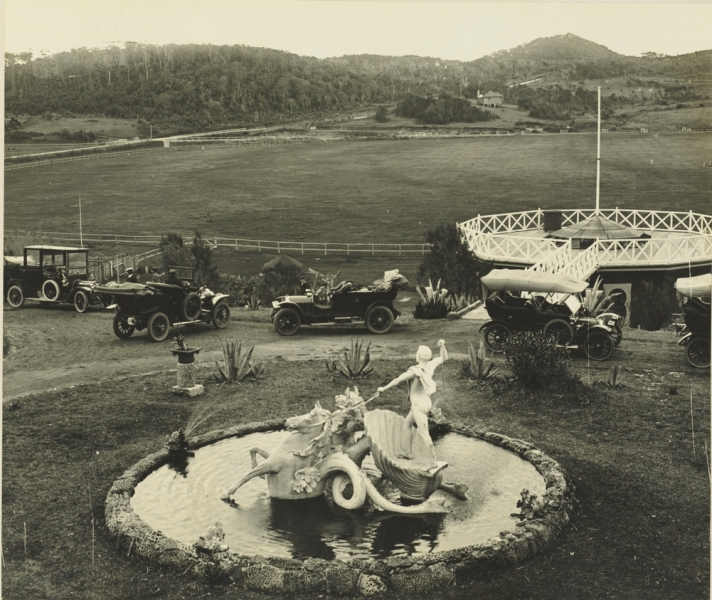
Brocks A Short Distance from the main building is an octagonal house of brick and wood, containing in the upper portion BALLROOM (12ft x 42ft) with up-to-date arrangements in basement. Advertising. (1907, April 27). The Sydney Morning Herald (NSW : 1842 - 1954), p. 22. Retrieved from http://nla.gov.au/nla.news-article28153265
How many decades did you have Bert King Constructions?
I was building up until 2002. I was the General Foreman at Mona Vale Hospital, built the hospital; had a couple of people helping me of course!! (laughs).
What was it like building Mona Vale Hospital?
The first nine months it was absolutely disgraceful; have you ever seen the fields of Flanders? The mud? It never stopped raining. It was a real battle. We were all in gum boots the whole time and mud, mud, mud. I joined Lend Lease before it was finished, they called me, and I became Building Manager at Lend Lease homes. I started Lend Lease Home Units and I had 22 blocks of home units going at one stage.
How old were you when you joined North Narrabeen SLSC?
 They didn’t have Nippers then, and they didn’t have cadets. They had an R&R Team and a little reel, Woofer Barnett, myself, Delore; we were doing Patrols when I was 12 years old.
They didn’t have Nippers then, and they didn’t have cadets. They had an R&R Team and a little reel, Woofer Barnett, myself, Delore; we were doing Patrols when I was 12 years old.
Who is ‘Woofer’ Barnett?
He was Wolfey Barnett’s son. He had all the toilet carts that used to go around the area, and the garbage trucks. Woofer is a very well known member of North Narrabeen, a lovely man. He died quite a few years back.
How did you come to move from Narrabeen to Newport?
I knew some of the boys in Newport Surf Club because they used to be member of 2nd Narrabeen Scouts, and as members of 2nd Narrabeen scouts that was the last troupe out on the way from Sydney. They used to meet at Carp street Narrabeen.
They were trying to talk me into coming to the club for years and I did after a blow-up with the Club Captain at North Narrabeen. Yes the boys asked me, Gerry Jeffries, Ian Milstead, Ronnie Walsh; they were all scouting mates. I joined Newport in the 1945-46 Season.
Picture: Surf Boat Crew; Ray Payne, John Harrison, Bert Payne and, front; Gerry Jeffery, John Illingsworth
Most of the members would have still been away serving then?
Yes; this is why it was hard trying to get the club going. There were people like Bert Payne, the butcher, and John Illingsworth that were doing their best to keep the club going. When I joined the club we only had 30 members.
When you think that in those days it took 24 members for a March Past you can see we used to do it a bit tough. They were pleased to get me and I was pleased to join there, and I’m still there. Strangely enough they had a very strong Ladies Surf Club at Newport at the time. The girls didn’t do Patrol work but they did a lot of good things for us and bought us our first new surf boat after the war; they used to have dances on Saturday nights in the clubhouse to raise funds to be able to do this.
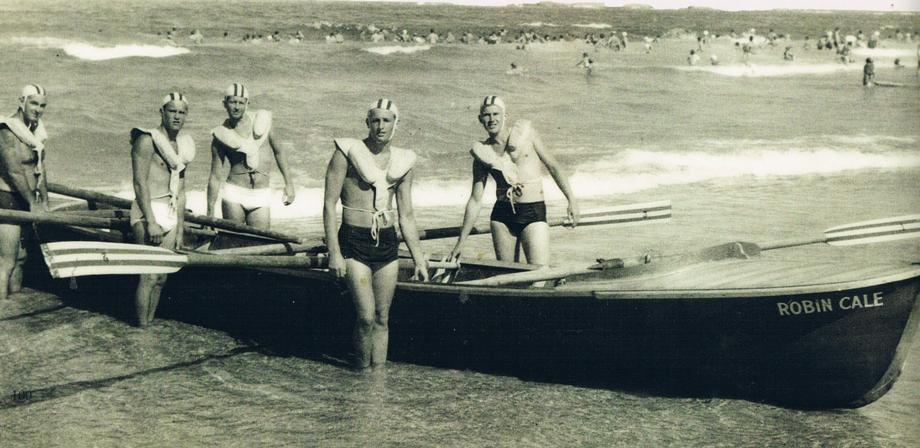
Newport Senior Boat Crew in 1963, from left: Bert King, Hermon Menses, Dave Petley, Ian Wilton and John Kinghorn. Gerry Jeferey remembers that in 1947 Bert was known as 'Killer King' after the boat was rowed from Newport with a rookie crew who did not know how to come aft. The boat was rolled at Bilgola and Bert had to swim ashore using the council line to rescue the crew and the boat. He had trouble getting a crew after that for a while. - Picture from Newport SLSC The First Century 1909 - 2009, compiled by Guy Jennings
Who was the band?
Oh, they were very special, they didn’t have a name; it was a piano and a set of drums, they used to come out from town.
What was the most memorable part of being a member at Newport SLSC then?
Well, for me, it was that I wanted to go into surf boats.
You were a very strong swimmer then too weren’t you?
I was. I won a scholarship to go into being coached by Harry Hay at Manly, he was the Olympic coach at that stage, and I was nine years old when I won that scholarship. It all fell to bits when mum died though. I won a few races in my time. I think the classic was this; in my final year at schools sports at Manly Boys, which was at Balgowlah now, there was these championships and they said “watch out for this young kid in first form, Max Riddington”, who is the present Riddington’s father.
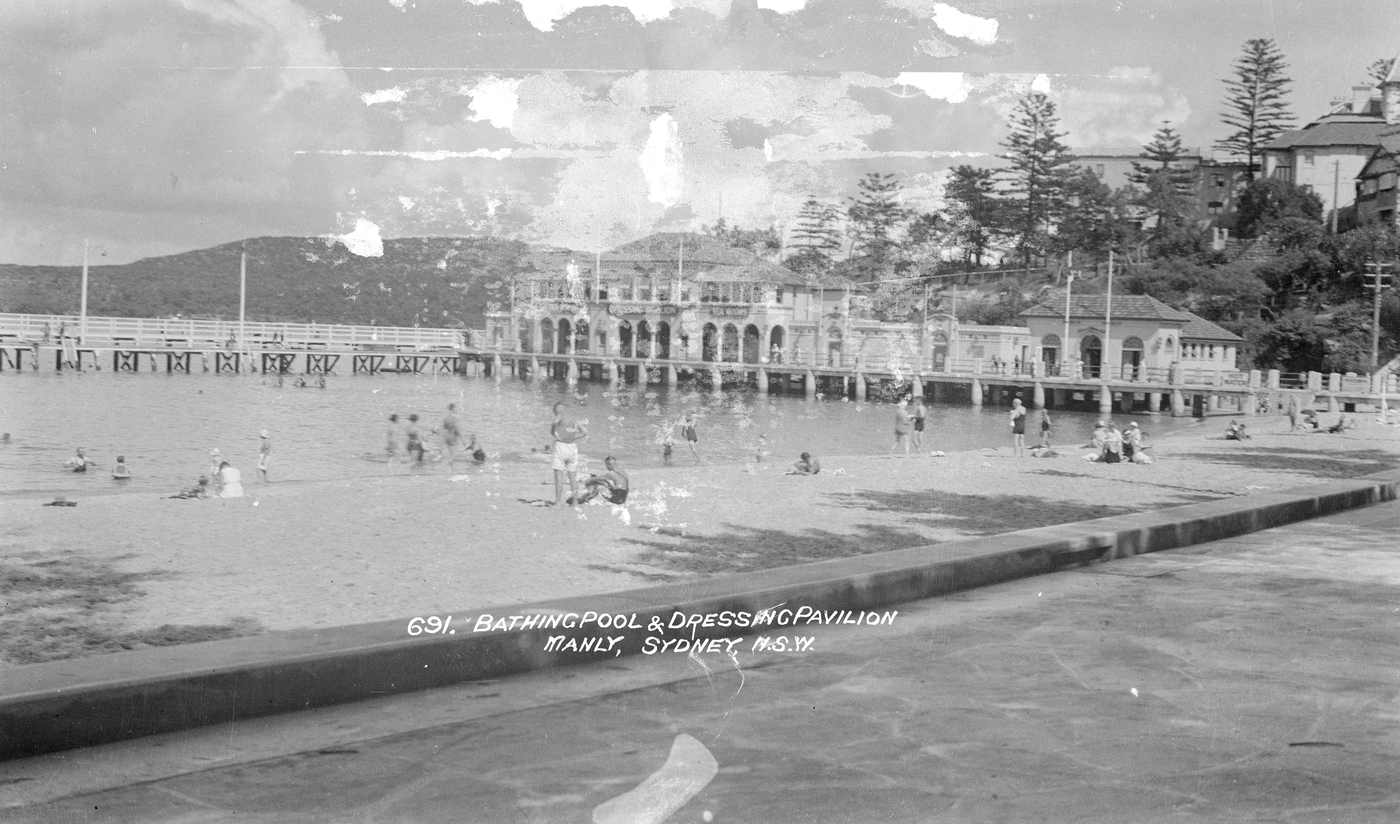
Samuel Wood - postcard photonegatives of Manly and Queenscliff, ca. 1928. Image No: a1470 Online, courtesy State Library of NSW
I said “oh, yeah, ok, he’s hot is he?” and they said, “oh yes, he’s hot”. So it was held in the old Baths which got demolished in the gales of 1974, and the starting pontoons used to go up and down, it was a tidal pool; there were no such things at tumble turns, it was touch turns.
I swam the race and looked to the left, looked to the right, and there was no one else on the pontoon. I though “oh well, so much for Riddington.” Then I looked up on the top and he’s up on the promenade already, drying himself!
(Bert Smiles and chortles)
Did you ever beat him?
No, never swam against him again like that; think I swam against him in a team’s race, but that was it. He wrote me a lovely letter a couple of years back as there had been an article in the paper about the third generation of Kings in the surf boats, and Max wrote that he remembered the times and that he was very pleased I went to surf boats as he thought we might have some real touch and go going around the cans. You see, in those days, when you were trying to get the inside going around the cans giving someone a kick in the face was all fair game.
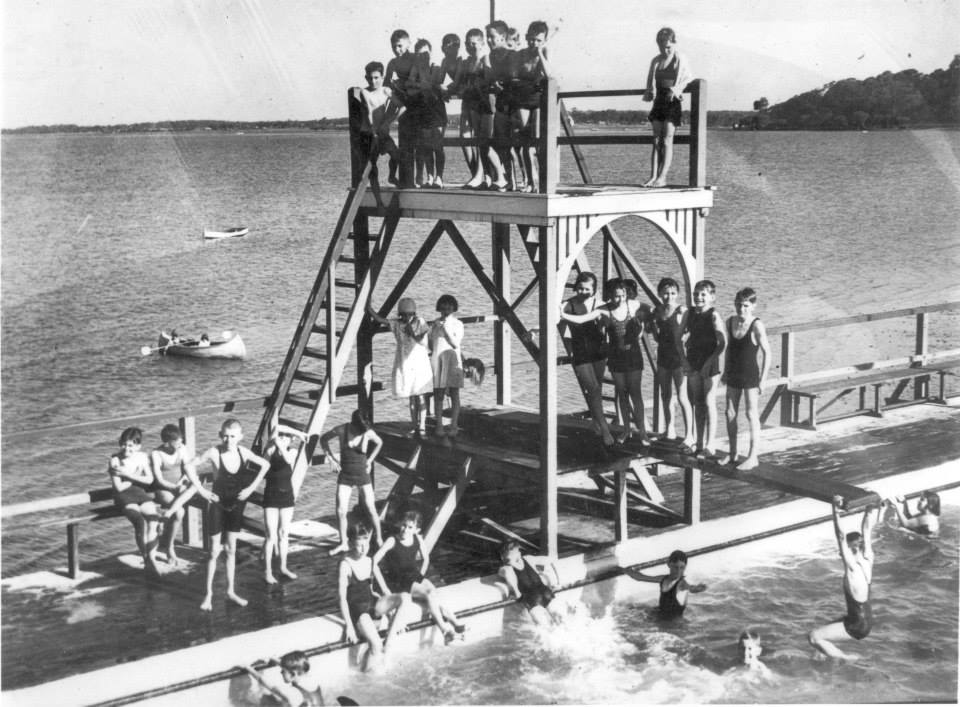
How old were you when you went over to surf boats?
 I was probably 15 when I got fully into it. The first bloke that ever put me in surf boats was Teddy Jorgensen. The Jorgensen’s were a family at Narrabeen and Ross Jorgensen was quite a famous surfer sweep and Ted was his son. Teddy used to put me in the boat, much to the annoyance of the club captain at North Narrabeen, and I must admit I didn’t go train as I should have for the swimming; apart from catching the tram to go training before school and after school; I’d have to catch the earlier tram and go walking around to the old Baths, do my laps and get roared at by Harry; “get off that kicking board!” ... he’d be talking to someone over this side and I’d go past, up on top of the kicking board having a bludge.
I was probably 15 when I got fully into it. The first bloke that ever put me in surf boats was Teddy Jorgensen. The Jorgensen’s were a family at Narrabeen and Ross Jorgensen was quite a famous surfer sweep and Ted was his son. Teddy used to put me in the boat, much to the annoyance of the club captain at North Narrabeen, and I must admit I didn’t go train as I should have for the swimming; apart from catching the tram to go training before school and after school; I’d have to catch the earlier tram and go walking around to the old Baths, do my laps and get roared at by Harry; “get off that kicking board!” ... he’d be talking to someone over this side and I’d go past, up on top of the kicking board having a bludge.
Anyway, these chaps and myself we got into a decent sort of a boat crew at Newport and in 1948-49 was the year we came second in the Australians. I still reckon we beat Manly. It took the judges half an hour to give a decision. It was at Bondi. I was 18 years old then, stroking the crew. I looked across as we went over the line and I was sure we were in front of Manly, but anyway, that’s history.
What were the surf carnivals like then?
After the war we used to travel in trucks with the boats upside down in the truck and the boys would sit under the boats in the back of the truck. I went to carnivals like that. In fact my godfather was killed on the Spit Bridge, Wally Proudfoot; I think he’d just won the State or the Australian Championship, he was from Narrabeen, a very famous swimmer, and on the way back home from the Carnival he got sideswiped off the back of the truck going over the Spit Bridge.
Left: Bert King, 1951
Apart from being Newport SLSC Club Captain from 1963-65 and Club President from 1970-72, you’ve also taken on many roles within SLSC?
I ran the N.S.W.’s sweep school later on, taught there later on in my career in Surf Life Saving at the State Centre. I did that for ten or fifteen years, starting in the 1960’s. I became Branch President. Together with Dennis Green we organised the first courses for qualifications for officials; I had to get all the seniors in Surf Life Saving at National and State level together to put them through their first course. So whilst I wasn’t patrolling I was still very much involved. I became Surfcraft Officer of Australia, which meant I was in charge of all boats, boards, surf skis and their technical designations. I originally became a boat inspector around 1965/66.
What did that involve?
Every surf boat had to be inspected three times during construction, and its builder. You had to sign a certificate saying you’d seen it. You had to check the measurements; it had to be specific measurements in length and width and depth.
Who were the main boat builders then?
When I took over it was Bill Barnett, who built the America’s Cup yachts, there was Roy Phillips who was in Balmain, Towner on the Parramatta river out at Haberfield way; they built a good boat. They all built good boats. In later years this area had the largest number of surf boat builders in the country.
We had Bill Filer, Roger Noon. Ken Beashell built a few surf boats; but he took it on himself to alter the specifications a bit and I got a kick in the bum over it because I’d stamped the boat as ‘experimental’. He’d put in the wrong timber in the gunwale and they said it was oversized but it was good timber, it was satisfactory.
It was ... that had the job that I eventually took over in Surf Club Council as an Officer, and he was adamant that it was wrong. So Ken Beashell and I had to face the hierarchy; I got a kick in the bum and Ken got suspended for a couple of years and he never built another surf boat after that. This was a shame because he had some really good innovative ideas which we all then lost.
It’s unfortunate that the first person to try and take an idea forward often gets trodden on for their efforts.
Tell me about it! It reminds me of when I started power surf rescue, the Power Boats.
How did that all come about?
In 1964/65 we had a pretty nasty rescue off Avalon, the police called us out, we didn’t have radio in those days. Bilgola couldn’t get out, there was a huge sea running, and Avalon were trying to get out and couldn’t, and Whale Beach couldn’t get out and I managed to get out, mainly because of the protection of the reef I think.
I took a crew and they rowed their hearts out to get there; it was at North Avalon, just where the rip comes out. There were not a lot of board riders around in those days, in the clubs, if it had been today the boardies would have been out there.
Anyway, we got there and the crew were reasonably exhausted, they rowed their hearts out to get there, and then there was only one thing to do; I had to do the swim out of the boat with the belt because that’s what we had; belt and lines in the boat. There were two of them; one bloke was semi-conscious when I got there and the other bloke was trying to hold him up. We got dragged out through the sea; and that’s a good experience for the patients, being dragged out through the sea by the blokes rowing the boat (chuckles). We got them into the boat further outside.
We battled our way back to Newport and I said to the boys, “the only way we’re going to get in safely here is if I take the biggest wave I can find…now you, you look after this bloke (one bloke was on the bottom; they’d been doing resuscitation on him) as we’re going in, and I had one tucked between my legs behind the quarter bar.
So a big wave came and I said to myself “God, don’t lose this, whatever you do.” And I cracked this big wave. By this time the clubbies had run down onto the beach and the police and they were expecting us, they were watching us.
So I cracked it, straight as a die, straight up the beach…whew !!!!
Got to the beach “Oh, no trouble at all mate, do this all the time!”
And I decided after that that there has got to be a better way.
So that’s when the Power Boats started coming in?
We started it at Newport. The first experiments we did when I started were we built a bracket for an outboard off the sweep out-rigger; and even that was controlled into the size and specifications of the boat. We were experimenting with it in Pittwater. The only trouble was when we put this, Peter Liddle; we borrowed his, 35hp Johnson motor onto a surfboat the last six feet of the boat stayed in the water and the rest of it was up in the air. The hulls weren’t designed for it.
We were going past the Royal Motor Yacht Club and the bloody thing flew off the bracket and went ‘chush!’ on the end of the fuel line doing cartwheels in the air. We had to get a diver to find it and get it back!
What was the name of this first Power Boat?
The ‘Bartender’. There’s a photo of it in the book the Newport SLSC – the First Century 1909 -2009 (compiled by Guy Jennings) That was only a standard runabout and we had a canvas cover over that. The second one was the one we developed with Bernard Dowd from the Bartender Safety Boat Company in 1966 and Victoria built it for us. This one was called ‘Ampol Rescue’. That’s stainless steel scuppers there, they were hinged, and a snorkel breathing for the engine which was in here, that was a 110hp Volvo. It was a magnificent surf boat, we did some horrendous and tremendous rescues in that one.
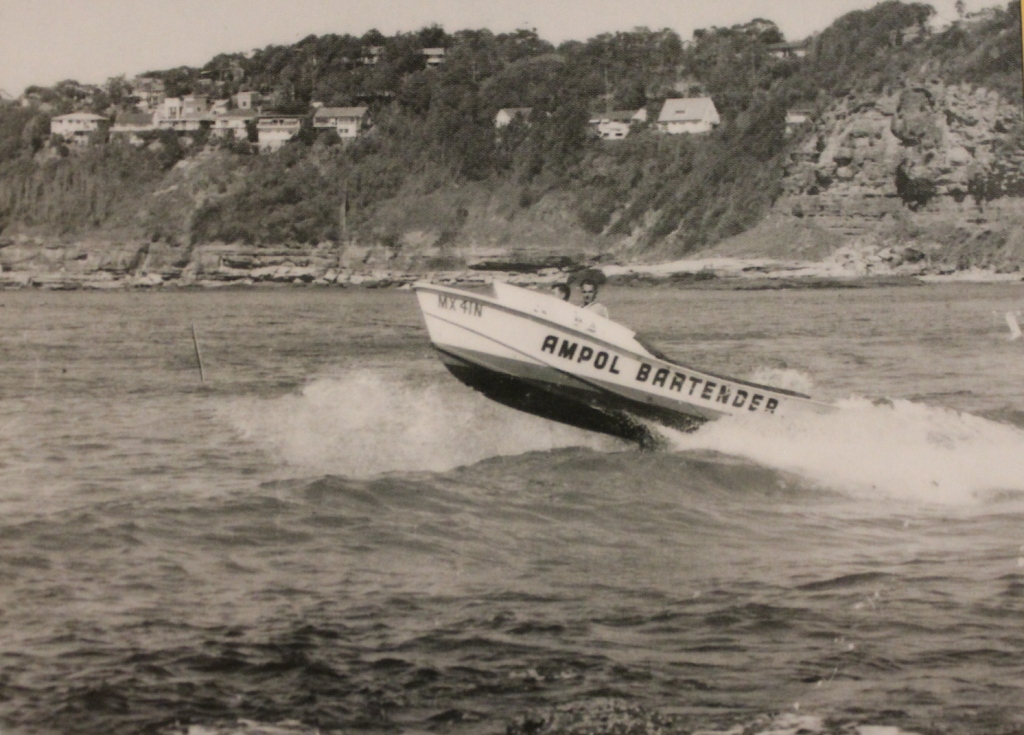
First Bartender off Whale Beach.
What was the first rescue the first Power Boat was used in?
The first rescue it was used in was at The Peak in Newport, which is off the reef at the northern end of Newport. I was out as we were still learning ourselves, we didn’t have a proper beach trailer then. A board-rider had gone under and there was a decent sea and Hopper, Jack Hopper and I were out learning.
This first boat you’ve got to realise was used to train the Victorian police; the Victorian police took on bartenders as their boats, it was an American design. The first one had a Johnson 8 in it which was a bit clapped out.
We had to go into the reef beside the break at The Peak, I leant over and grabbed this kid and threw him onto the cover at the back because it wasn’t designed for surf work. I thought I’d pulled my arm out of my shoulder. Anyway, I threw him up there and we came back. Now, unbeknownst to us, sitting on the top of the cliff at Newport watching us do the rescue was the General Manager of Ampol Australia. Allan Leslie was the Commodore of RMYC at the time and also a manger of some sort in Ampol at the time. He was driving the boss around and they ended up sponsoring our first boat built specifically for surf rescue. If you look at the book that will tell you all the awards for the boat.
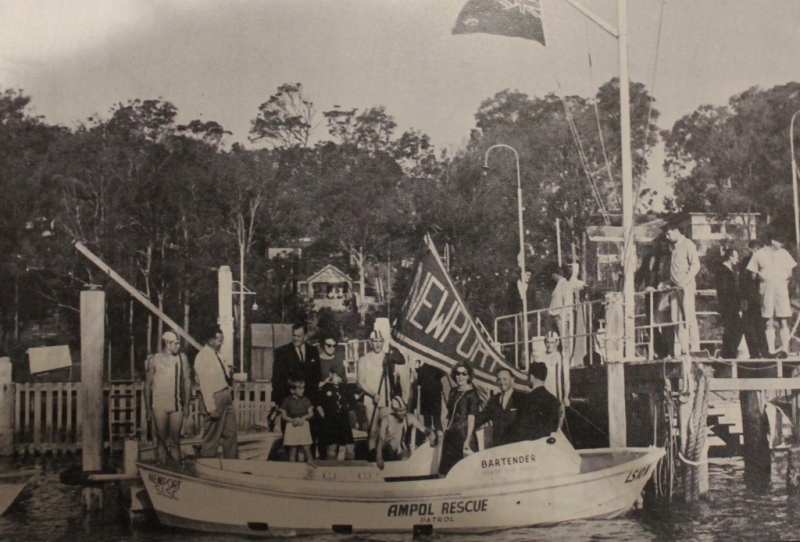
Second Bartender being launched at RMYC by Cmdr. Alan Leslie. Newport SLSC Patrons Kel Harrison, 3rd from left, also includes Bert, Michael and Peter King and Jack Hopper.
Then it was very obvious that the club needed some form of communication. Peter Liddle was involved in electronics, so we started the first two way radio. The licence for the two way radio for SLSC was in Newport’s name for probably ten years after that before we had to fold it up.
I was the first captain of Power Boats in Surf Life Saving and we got this radio and it was Newport that had the licence for ten or fifteen years before we packed up. The radio station used to be on top of the clubhouse, on top of where the boatshed is now. The radio set we had was pretty powerful, we could speak to New Zealand, and spoke quite often to the Patrols on Coolangatta on the Gold Coast. We (Newport SLSC)introduced radio to Surf Life Saving. Spellsen's had a nightclub in Newport and Mr Spellsen backed us and bought us the radio. Peter Liddle became Radio Officer for NSW originally and then Australia. He went up and down the coast establishing radio stations. He did a great job.
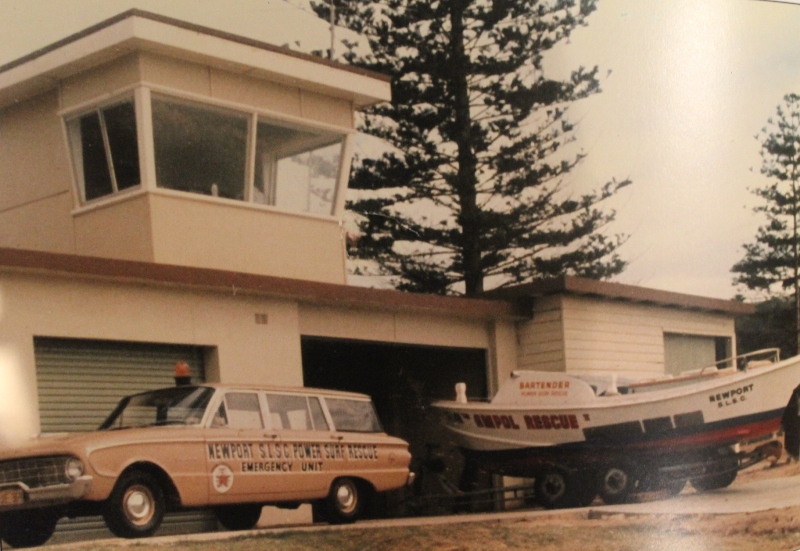
Radio Station above Boatshed.
How many seasons of Patrols have you done?
Well, I was always around, but you’ve got to understand I’d taken on positions further up.
June (wife): we stopped doing Patrols around about 1991.
Bert: June was a Patrol Captain too you see.
Bert and June, combined, have done around one hundred years of Patrols.
How many sons do you have?
I’ve got three and June has two. Five sons between us and one daughter.
How many grandchildren do you have?
Four on my side and seven on June’s side. My granddaughter has done very well last year, brought home five silver medals in the Branch championships (SLS).
How did you meet June?
 I met June at Queenscliff Surf Club, 1981. She was representing her company which sponsored the Queenscliff Surf Club, it was a carnival. It was the day I got my Life Membership for the Manly Warringah Branch and the President insisted I come to afternoon tea. I said, “Don’t be silly Paul, I’ve got a Boat Area to run.” And I think I had some refereeing to do too that day, or something like that.
I met June at Queenscliff Surf Club, 1981. She was representing her company which sponsored the Queenscliff Surf Club, it was a carnival. It was the day I got my Life Membership for the Manly Warringah Branch and the President insisted I come to afternoon tea. I said, “Don’t be silly Paul, I’ve got a Boat Area to run.” And I think I had some refereeing to do too that day, or something like that.
And he said, “Well, I’m not asking you now, I’m telling you, put on some shoes and socks and come up to afternoon tea, I want you to meet the official guests.”
So I eventually went to ‘afternoon tea’ and I’m looking at boat area and making sure everything is going alright and there was this lovely lady standing there and she had a lovely white what I call an A frame frock on, and a lovely smile on her face, and I thought, hell, that’s nice. So I got the boys to introduce me to her, and I said “are you going to be here after the carnival?” and she said “yes.” And I said, well I’ve got to go down and sort the boats out but after that I’d like to see you and talk to you. I took her out to dinner that night, straight off the beach, feeling scungy and salt laden, unclean and all that sort of thing. But we went out to dinner and we hit it off, and apart from when she had to go to New Zealand when her father was very ill, we’ve been together ever since. I’ve been a very lucky and very fortunate man.
Right: Bert KIng, 1968.
June had been involved in Queenscliff as a member but not actively. Paul got June to take on a job as Treasurer and … came in and said “what’s this; we’ve got someone on the executive that hasn’t got a Bronze Medallion?” So June went and did her Bronze Medallion and her daughter was her instructor. June wrote a program for running the Surf Carnivals for National Council. She also has a Life Membership of the Branch.
What is your favourite place or places in Pittwater and why?
I’m very partial to The Basin, and I like America’s Bay, because they’re quiet. Come and look at this; this is The Basin, this is one of my photos. And this one is America’s Bay; this one (Basin) I got up early, at dawn, when June and I were really early days together, and had a look, and thought, got to get my camera. I’m a mad photographer. That one of America’s Bay happened just after five of an afternoon. I love that photo, it shows the sun and the wind.
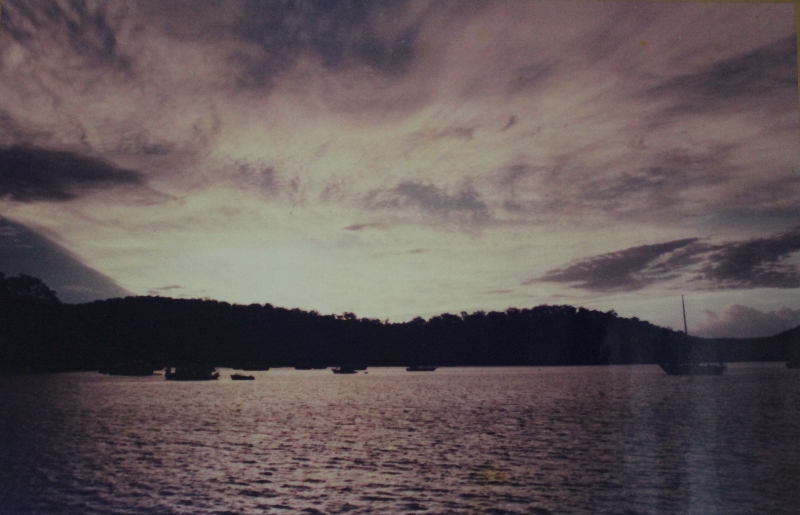
America's Bay by Bert King.
What was your boat called?
 Kahlua; we used to go out most weekends, or whenever we could. The boys gave us that for a wedding present, it’s an original oil painting, in fact it was still soft when we got it. This one; that’s a double ender, surf boat; ‘made by Buster Brown’; 26 foot long and I changed it from 22 feet long originally; Michael made that for me for my 60th birthday
Kahlua; we used to go out most weekends, or whenever we could. The boys gave us that for a wedding present, it’s an original oil painting, in fact it was still soft when we got it. This one; that’s a double ender, surf boat; ‘made by Buster Brown’; 26 foot long and I changed it from 22 feet long originally; Michael made that for me for my 60th birthday
What is your ‘motto for life’ or a favourite phrase you try to live by?
Could have been worse. And; These things take time.

The second Bert King surfboat. Photo by A J Guesdon, 2013.


Rob Emerson, current Presidnet of Newport SLSC with Bert and June King, 2013. Photo by A J Guesdon.
Copyright Bert King, 2013.
|
|